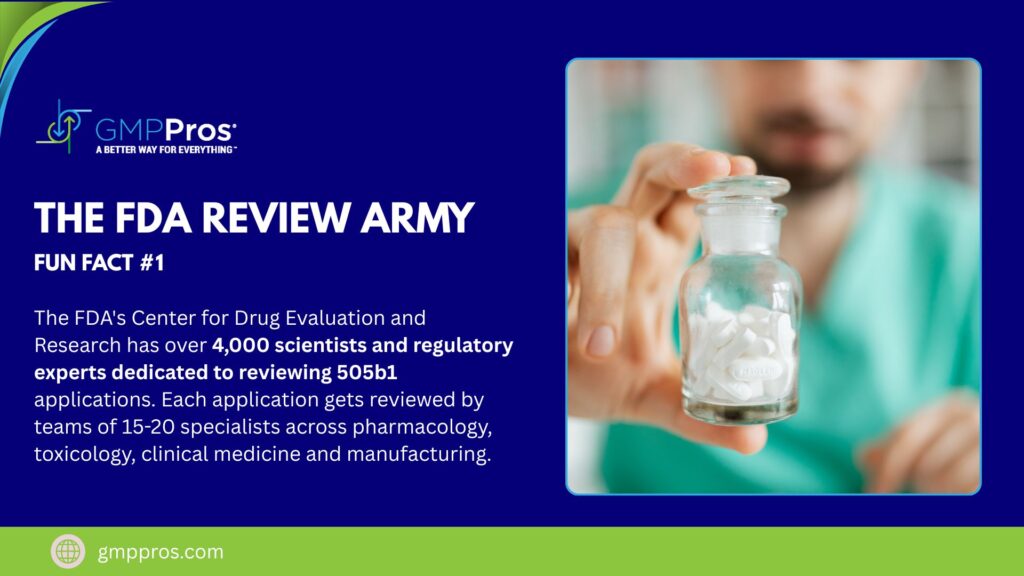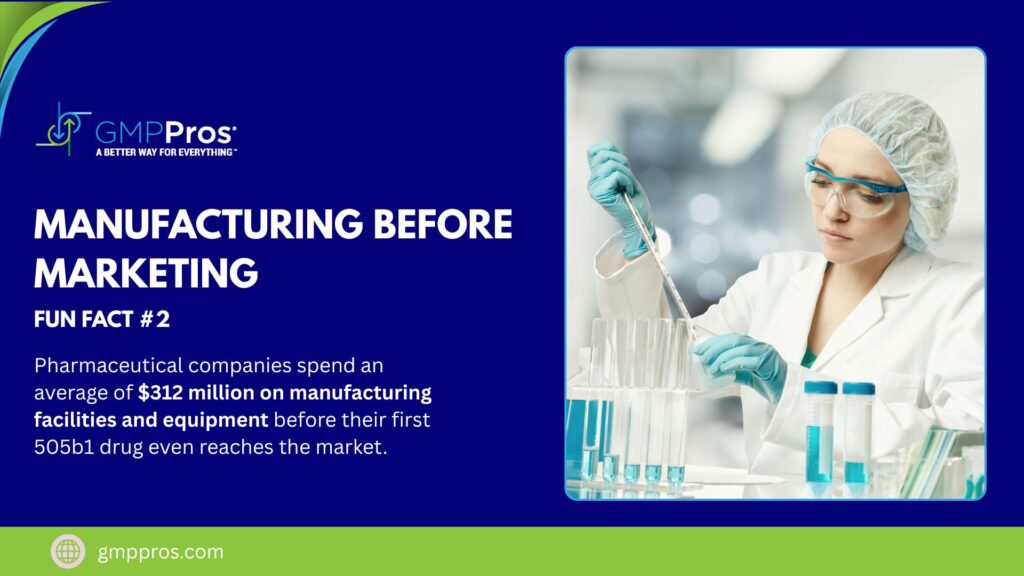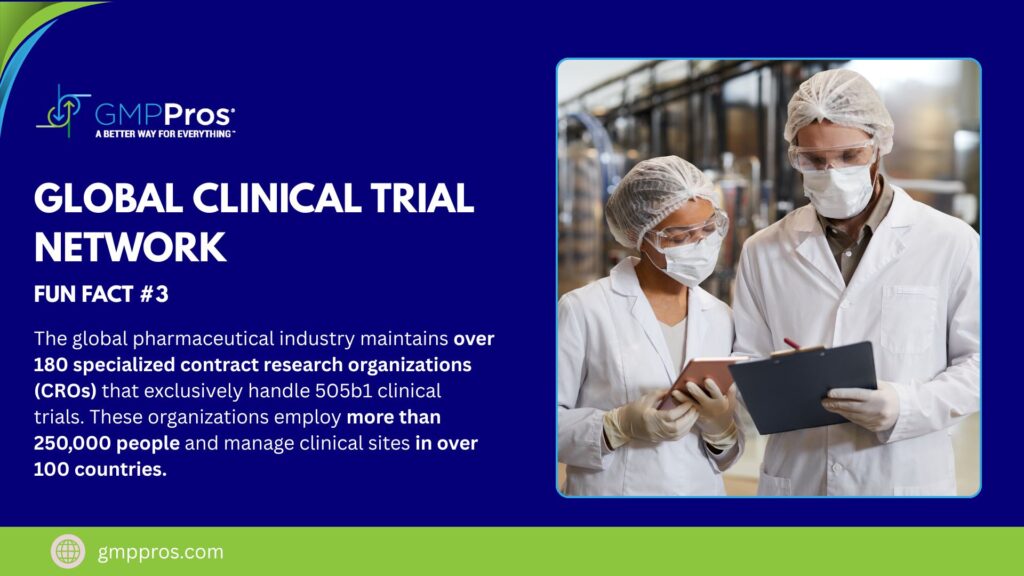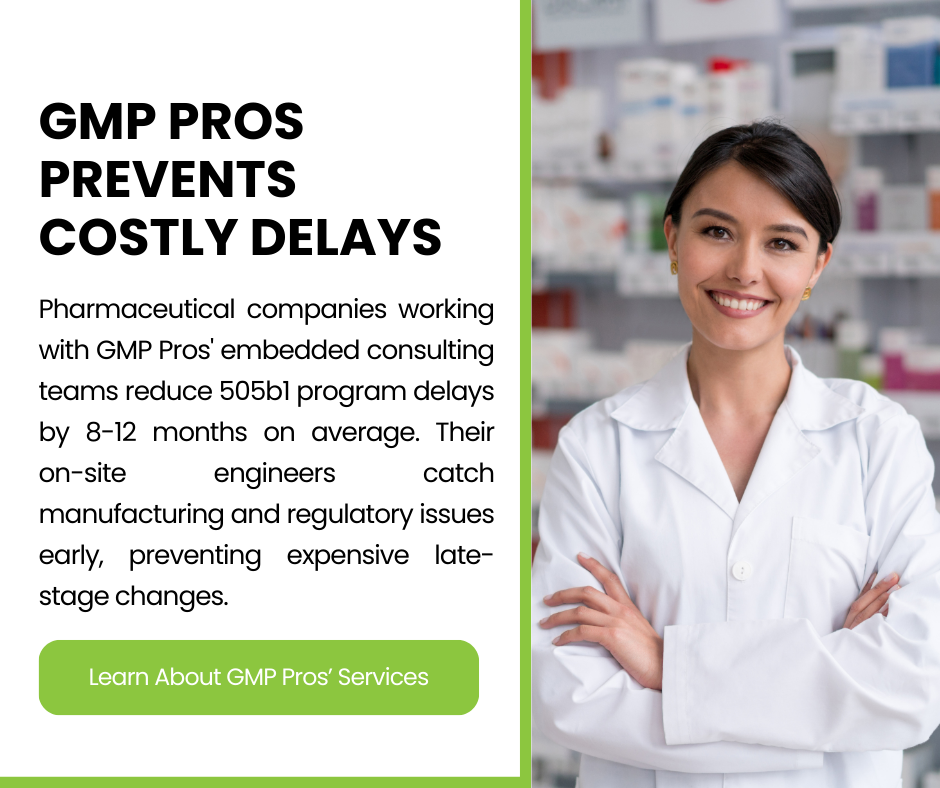In 2023, some analysis made by the FDA revealed that 67% of new drug applications still use the traditional 505b1 pathway despite longer development times.
Getting your 505b1 application right the first time saves you years of delays and millions of dollars in development costs. But one mistake in your submission can set your program back by 18 months or more.
This guide covers everything you need to know about 505b1 drug development, from initial planning through FDA approval and commercial manufacturing.
What Makes 505b1 Drug Development Different
The 505b1 pathway requires complete clinical data packages to prove safety and effectiveness. You cannot rely on existing drug data to support your application, unlike other FDA pathways
The 505b1 drug works best for truly innovative drugs that don’t have comparable products already on the market. First-in-class medications and novel therapeutic approaches typically go through 505b1 development.
Most pharmaceutical companies choose this pathway when their drug represents a significant advancement over existing treatments. The extra time and cost investment pays off with stronger market exclusivity protection.

Regulatory Requirements You Must Meet
FDA expects full preclinical and clinical development programs for 505b1 applications. Every safety and effectiveness claim needs supporting data from your own studies.
Manufacturing data must demonstrate consistent quality across all proposed commercial sites. Process validation becomes critical since you can’t reference established manufacturing methods.
Quality systems need complete documentation from development through commercial production. Missing or incomplete records cause major delays during FDA review.
- Common Development Challenges
Many 505b1 programs face common hurdles during their development and regulatory review and you need to understand these barriers in order to make better planning for the timeline and budget.
One of the biggest challenges is the design of clinical trials. Recruitment for novel therapies tends to take more time than traditional therapeutic areas.
Sometimes scale-up for manufacturing will present unexpected technical issues. Laboratory processes usually don’t transfer well to commercial production equipment.
505b1 vs 505b2 Drugs Pathways
The main difference between these pathways comes down to data requirements and development timelines. Each route serves different types of drug development programs.
Pathway | Data Requirements | Typical Timeline | Best For |
505b1 | Complete clinical package | 8-12 years | Novel drugs, first-in-class |
505b2 | Some existing data allowed | 3-8 years | Improved formulations, new indications |
If you want to learn more about alternative FDA approval pathways, you can check out our article for 505b2 drugs.
When to Choose The 505b1 Drug
Companies typically select 505b1 for breakthrough therapies and innovative drug mechanisms. This pathway gives you the strongest intellectual property protection but requires the most investment.
Novel drug delivery systems often need 505b1 development even when the active ingredient exists. New formulations that change how the body processes the drug usually can’t rely on existing safety data.
Combination products with unique therapeutic benefits typically require full 505b1 development programs. FDA wants to see how the components work together in your specific formulation.
505b2 Application Considerations
The 505b2 application pathway lets you reference some existing data to support your drug approval. This approach works well for improvements to existing therapies.
New dosing regimens or patient populations often qualify for 505b2 development. You still need clinical data but can build on established safety information.
Generic drug companies sometimes use 505b2 when their product differs significantly from the reference drug. Minor formulation changes might not require full 505b1 development.
Essential Development Planning Steps
A recent industry study found that 54% of 505b1 programs exceed their original timelines by more than two years due to poor upfront planning.
Smart pharmaceutical companies invest heavily in development planning before starting expensive clinical trials. Proper planning prevents costly mistakes and regulatory delays.
Target product profiles guide every decision from formulation through commercial manufacturing. Clear specifications help teams stay focused on regulatory requirements.

Preclinical Development Strategy
Preclinical studies form the foundation of your 505b1 application. FDA uses this data to evaluate whether human testing is safe and reasonable.
Toxicology studies must cover all proposed patient populations and treatment durations. Animal safety data directly influences clinical trial design and dosing strategies.
Pharmacology studies establish how your drug works in the body. This data supports dosing recommendations and helps predict clinical effectiveness.
| Study Type | Purpose | Timeline |
| Toxicology | Safety assessment | 12-18 months |
| Pharmacokinetics | Drug absorption/elimination | 6-12 months |
| Efficacy | Therapeutic effect | 12-24 months |
- Clinical Development Approach
Clinical development typically represents the largest cost and time investment in 505b1 programs. Phase I through Phase III studies can take 5-8 years to complete.
Patient recruitment strategies need early planning since novel therapies often target small populations. Rare disease programs face especially difficult enrollment challenges.
Manufacturing supply for clinical trials requires careful coordination. You need enough drug product for all planned studies plus potential extensions or additional trials.
Manufacturing Considerations for 505b1
Manufacturing development runs parallel to clinical programs throughout 505b1 drug development. Early manufacturing decisions affect your entire commercial strategy.
Process development must balance cost, quality, and regulatory requirements. Changes become much more expensive and time-consuming after clinical trials start.
Many companies implement mes implementation during development to ensure consistent manufacturing processes. Digital systems help maintain data integrity and support regulatory submissions.
- Technology Transfer Challenges
Moving from development labs to commercial manufacturing sites creates technical and regulatory challenges. Process differences between sites can affect product quality and FDA approval.
Scale-up studies prove that larger equipment produces equivalent products. FDA expects validation data showing consistent quality across all manufacturing scales.
Technology transfer documentation must capture every critical process parameter. Missing information during scale-up leads to manufacturing problems and regulatory delays.
- Quality System Requirements
Quality systems for 505b1 drugs need complete documentation from development through commercial production. FDA inspects these systems as part of the approval process.
Change control procedures become critical once clinical trials begin. Any manufacturing changes require careful evaluation and potential clinical impact assessment.
Training programs must ensure all personnel understand cGMP requirements for novel drug manufacturing. New products often have unique quality control requirements.
Digital Systems Integration
Modern pharmaceutical manufacturing relies heavily on digital systems to ensure compliance and quality. Most companies need mes implementation steps to integrate these technologies effectively.
Manufacturing execution systems track every batch from raw materials through finished products. This data becomes essential during regulatory inspections and product investigations.
Advanced companies use sap mes implementation to connect manufacturing with business systems. Integration improves visibility and supports better decision-making across the organization.
Implementation Project Planning
A 2024 manufacturing technology study showed that pharmaceutical companies with proper mes implementation project plan complete system deployments 40% faster than those without structured approaches.
System requirements must align with both current operations and future commercial needs. Under-specified systems create problems when production volumes increase after approval.
Validation activities for digital systems require significant time and resources. FDA expects these systems to meet the same quality standards as manufacturing equipment.
| Implementation Phase | Duration | Key Activities |
| Planning & Design | 3-6 months | Requirements, system selection |
| Configuration | 6-12 months | System setup, testing |
| Validation | 3-6 months | Documentation, FDA readiness |
- Data Integrity Considerations
Data integrity requirements apply to all systems used in pharmaceutical manufacturing. Electronic records must be complete, consistent, and secure throughout the product lifecycle.
Audit trails capture every system interaction and data change. FDA inspectors review these records to verify compliance with cGMP regulations.
Backup and disaster recovery procedures protect critical manufacturing data. System failures can disrupt production and delay product deliveries to patients.

Regulatory Submission Strategy
FDA submission strategy affects both approval timelines and commercial success. Well-planned submissions move through review faster and with fewer information requests.
Pre-submission meetings with FDA help align development programs with regulatory expectations. These discussions can prevent expensive late-stage changes to your application.
Rolling submissions let you submit completed sections while finishing other parts of your application. This approach can reduce overall review timelines for complex programs.
Application Components
505b1 applications contain thousands of pages covering every aspect of drug development and manufacturing. Organization and clarity help FDA reviewers evaluate your submission efficiently.
Clinical data represents the largest section of most applications. Study reports must clearly demonstrate safety and effectiveness for all proposed uses.
Manufacturing information includes facility descriptions, process validation, and quality control methods. FDA uses this data to determine inspection priorities and approval conditions.
Review Timeline Expectations
Standard FDA review takes 10-12 months for complete 505b1 applications. Priority review programs can reduce this timeline to 6-8 months for breakthrough therapies.
Information requests during review can extend timelines significantly. Thorough preparation and clear documentation reduce the likelihood of FDA questions.
Advisory committee meetings may be required for controversial or complex applications. These public meetings add 3-6 months to the review process but provide valuable input.
Post-Approval Manufacturing Requirements
FDA approval triggers new manufacturing and reporting requirements that continue throughout the product lifecycle. Compliance costs increase significantly after commercial launch.
Annual reports document manufacturing changes, adverse events, and quality metrics. Late or incomplete reports can result in warning letters and regulatory action.
Implementing sap manufacturing execution systems helps companies manage these ongoing requirements efficiently. Automated reporting reduces compliance costs and improves accuracy.
- Commercial Manufacturing Validation
Commercial manufacturing validation proves that your approved processes consistently produce quality products. This work typically begins 6-12 months before approval.
Process performance qualification studies must demonstrate consistent results across multiple batches. FDA expects statistical analysis showing process capability and control.
Continued process verification ensures ongoing manufacturing performance meets approval specifications. Out-of-specification results require investigation and potential regulatory notification.
Cost Management Strategies
505b1 development costs typically range from $500 million to $2 billion depending on therapeutic area and program complexity. Smart budget management helps companies survive the long development timelines.
Manufacturing development represents 15-25% of total program costs. Early investment in robust processes prevents expensive changes during later development phases.
Digital system investments pay for themselves through improved efficiency and compliance. Companies with modern manufacturing systems report 20-30% lower regulatory compliance costs.
- Resource Allocation Planning
Development teams need specialized expertise across multiple functional areas. Contractor support often provides more flexibility than hiring permanent staff for specific project phases.
Clinical operations typically consume 40-60% of development budgets. Efficient trial design and execution significantly impact overall program economics.
Regulatory consulting helps companies navigate complex FDA requirements. Expert guidance prevents costly mistakes and accelerates approval timelines.
Common Pitfalls and Solutions
Most 505b1 programs encounter predictable challenges that can be avoided with proper planning and execution. Learning from industry experience prevents expensive mistakes.
Inadequate manufacturing development causes problems during scale-up and technology transfer. Early investment in process understanding saves time and money later.
Poor data management creates compliance issues and delays regulatory submissions. Modern data systems prevent these problems and improve overall program efficiency.
- Risk Mitigation Approaches
Risk assessment should identify potential problems before they impact program timelines. Contingency planning helps teams respond quickly when issues arise.
Quality by design approaches build robustness into development processes. Understanding critical quality attributes prevents manufacturing problems and regulatory delays.
Cross-functional communication ensures all teams understand program requirements and timelines. Regular reviews identify emerging issues before they become major problems.

What We Can Say As a Conclusion
505b1 drug development requires careful planning and execution across multiple functional areas. Success depends on understanding FDA requirements and building robust development processes from the start.
Smart pharmaceutical companies invest in proper manufacturing systems and regulatory expertise early in development. These investments pay for themselves through faster approval timelines and lower compliance costs.
GMP Pros specializes in helping pharmaceutical manufacturers navigate complex 505b1 development programs. Our embedded consulting approach ensures your team has the expertise needed for successful FDA approval.
Contact GMP Pros today to learn how our pharmaceutical engineering and regulatory experts can accelerate your 505b1 program while reducing development risks and costs.
For More:

